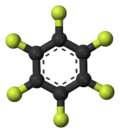Hexafluorobenzene
| Hexafluorobenzene | |
|---|---|
 |
 |
| IUPAC name Hexafluorobenzene | |
| Other names Perfluorobenzene | |
| Identifiers | |
| CAS number | 392-56-3 |
| PubChem | 9805 |
| ChemSpider | 13836549 |
| ChEBI | CHEBI:38589 |
| Jmol-3D images | Image 1 |
| |
| |
| Properties | |
| Molecular formula | C6F6 |
| Molar mass | 186.05 g mol−1 |
| Appearance | Colorless liquid |
| Density | 1.6120 g/cm3 |
| Melting point | 5.2 °C; 41.4 °F; 278.3 K |
| Boiling point | 80.1 °C; 176.2 °F; 353.2 K |
| Refractive index (nD) | 1.377 |
| Viscosity | cP (1.200 mPa•s) (20 °C) |
| Dipole moment | 0.00 D (gas) |
| Hazards | |
| EU classification | Highly Flammable (F) |
| R-phrases | R11 |
| S-phrases | S33 S29 S9 S16 |
| Flash point | 10 °C[1] |
| Related compounds | |
| Related compounds | Benzene Hexachlorobenzene Polytetrafluoroethylene |
| Except where noted otherwise, data are given for materials in their standard state (at 25 °C (77 °F), 100 kPa) | |
| Infobox references | |
Hexafluorobenzene, HFB, C
6F
6, or perfluorobenzene is an organic, aromatic compound. In this derivative of benzene all hydrogen atoms have been replaced by fluorine atoms. The technical uses of the compound are limited, although it is recommended as a solvent in a number of Photochemical reactions. In the laboratory hexafluorobenzene is used for several purposes:
- standard in Fluor-19 NMR
- solvent and standard in Carbon-13 NMR
- solvent in Proton-NMR
- solvent when studying some parts in the IR-spectrum
- solvent in UV-spectra, as hexafluorobenzene itself hardly shows any absorbance in the UV region.
Geometry of the aromatic ring
Hexafluorobenzene in the perhalogenbenzenes stands somewhat aside. When counting for bond angles and distances it is possible to calculate the distance between two ortho fluorine atoms. Also the non bonding radius of the halogens is known. The following table presents the results:[2]
| Formula | Name | Calculated inter-halogen distance, aromatic ring assumed planar |
Twice nonbonding radius | Consequent symmetry of the benzene |
|---|---|---|---|---|
| C6F6 | hexafluorobenzene | 279 | 270 | D6h |
| C6Cl6 | hexachlorobenzene | 312 | 360 | D3d |
| C6Br6 | hexabromobenzene | 327 | 390 | D3d |
| C6I6 | hexaiodobenzene | 354 | 430 | D3d |
The conclusion of the table is HFB is the only perhalobenzene being planar, the others all are buckled more or less. As a consequence in C6F6 the overlap between the p-orbitals is optimal, while in the others it is less, also giving rise to a lower aromaticity in those compounds.
Synthesis
The direct synthesis of hexafluorobenzene from benzene and Fluorine is not possible. The synthetic route proceeds via the reaction of alkali-fluorides with halogenated benzene:[3]
- C6Cl6 + 6 KF → C6F6 + 6 KCl
Fluorine and the aromatic ring
A substantial part of the chemistry of HFB is related to the position of fluorine in the periodic table. On its position at the end of the first row, fluorine is a halogen. It also is the smallest one, so taking up an electron releases the largest amount of energy of all elements, it is the strongest oxidant, it has the highest electronegativity. The carbon fluorine bond therefore is highly polarized: the carbon atom has (partially) positive charge, fluorine negative. This reasoning holds very much for the electrons in the σ-bonds. Electrons in p-orbitals encounter a totally different situation. The p-orbital at fluorine parallel to the one on the adjacent carbon will face an optimal interaction. Thereby fluorine, unlike the higher halogens, has no extra nodal plane in its orbitals, so size and geometry fit perfectly and no anti-bonding interactions occur. The dipole resulting from the σ-electronegativity will force a partial replacement of electric charge from fluorine towards carbon and the aromatic ring: fluorine behaves as a σ-electronegative, but as a π-electropositive element. This view is supported by the reactions C6F6 exhibits.
Reactions
With regard to its reactions, HFB stands apart from other aromatic compounds. One of the main reactions of aromatics is electrophilic aromatic substitution which for C6F6 is impossible. During the reaction a particle initially bonded to the aromatic nucleus leaves the molecule as a positive charge ion. In benzene, this is a H+-ion. In hexafluorobenzene a positive charged fluorine atom should have to leave, which does not occur. The vast number of reactions of HFB proceed with fluoride—negative charged—as leaving group. As a consequence the entering group also should be an anion.
The reaction of pentafluorophenyl derivatives has been long puzzling for its mechanism. Independent of the substituent, they all exhibit an para directing effect. The new introduced group too has no effect on the directing behaviour. In all cases, a 1,4-disubstituted-2,3,5,6-tetrafluorobenzene derivative shows up. Finally, the clue is found not in the nature of the non-fluorine substituent, but in the fluorines themselves. The π-electropositive effect introduces electrons into the aromatic ring. The non-fluorine substituent is not capable of doing so. As charge accumulates at the ortho and para positions relative to the donating group, the ortho and para-positions relative to the non-fluorine substituent receive less charge, so are less negative or more positive. Furthermore the non-fluorine substituent in general is more bulky than fluorine, so its ortho-positions are sterically shielded, leaving the para-position as the sole reaction site for anionic entering groups.
Biomedical Applications
Hexafluorobenzene (HFB) has been used as a reporter molecule to investigate tissue oxygenation in vivo. It is exceedingly hydrophobic, but exhibits high gas solubility with ideal liquid gas interactions. Since molecular oxygen is paramagnetic it causes 19F NMR spin lattice relaxation (R1): specifically a linear dependence R1= a + bpO2 has been reported.[4] HFB essentially acts as molecular amplifier, since the solubility of oxygen is greater than in water, but thermodynamics require that the pO2 in the HFB rapidly equilibrates with the surrounding medium. HFB has a single narrow 19F NMR signal and the spin lattice relaxation rate is highly sensitive to changes in pO2, yet minimally responsive to temperature. HFB is typically injected directly into a tissue and 19F NMR may be used to measure local oxygenation. It has been extensively applied to examine changes in tumor oxygenation in response to interventions such as breathing hyperoxic gases or as a consequence of vascular disruption.[5] MRI measurements of HFB based on 19F relaxation have been shown to correlate with radiation response of tumors.[6] HFB has been used as a gold standard for investigating other potential prognostic biomarkers of tumor oxygenation such as BOLD (Blood Oxygen Level Dependant),[7] TOLD (Tissue Oxygen Level Dependant) [8] and MOXI (MR oximetry) [9] An extensive review of applications is provided in.[10]
Literature
- Walter J. Pummer, Leo A. Wall: „Reactions of Hexafluorobenzene“, Science, 1958, Vol. 127, Nr. 3299, pp. 643–644; doi:10.1126/science.127.3299.643.
- Harold Crosbie Fielding: „Preparation of hexafluorobenzene and fluorochlorobenzenes“, US-Patent 3277192, 4. October 1966.
- M. D. Bertolucci, R. E. Marsh: „Lattice parameters of hexafluorobenzene and 1,3,5-trifluorobenzene at −17 °C“, J. Appl. Cryst., 1974, 7, pp. 87–88; doi:10.1107/S0021889874008764.
References
- ↑ Across Organics:Catalog of fine Chimcals (1999)
- ↑ P. Delorme, F. Denesselle: J. Chem. Phys., jaargang 64, pagina 591 (1967).
- ↑ N. N. Vorozhtsov, V. E. Platonov, G. G. Yakobson: "Preparation of hexafluorobenzene from hexachlorobenzene", Russian Chemical Bulletin, 1963, 12 (8), p. 1389; doi:10.1007/BF00847820.
- ↑ Zhao D, Jiang L, Mason RP. Measuring Changes in Tumor Oxygenation. Methods Enzymol 2004;386:378-418.
- ↑ Zhao D, Jiang L, Hahn EW, Mason RP. Tumor physiological response to combretastatin A4 phosphate assessed by MRI. Int J Radiat Oncol Biol Phys 2005; 62:872-880.
- ↑ Zhao D, Constantinescu A, Chang C-H, Hahn EW, Mason RP. Correlation of Tumor Oxygen Dynamics with Radiation Response of the Dunning Prostate R3327-HI Tumor. Radiat Res 2003;159:621-631
- ↑ Zhao D, Jiang L, Hahn EW, Mason RP. Comparison of 1H blood oxygen level-dependent (BOLD) and 19F MRI to investigate tumor oxygenation. Magn Reson Med 2009;62(2):357-364.
- ↑ Hallac RR, Zhou H, Pidikiti R, Song K, Stojadinovic S, Zhao D, Solberg T, Peschke P, Mason RP. Correlations of noninvasive BOLD and TOLD MRI with pO2 and relevance to tumor radiation response. Magn Reson Med 2013:in the press DOI 10.1002/mrm.24846 early view.
- ↑ Zhang Z, Hallac RR, Peschke P, Mason RP. A noninvasive tumor oxygenation imaging strategy using magnetic resonance imaging of endogenous blood and tissue water. Magn Reson Med 2013 (early view http://dx.doi.org/10.1002/mrm.24691 );in press:n/a-n/a.
- ↑ Yu J-X, Hallac RR, Chiguru S, Mason RP. New frontiers and developing applications in 19F NMR. Progr Nucl Magn Reson Spectrosc 2013;70(0):25-49.